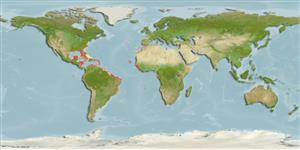Common names from other countries
Environment: milieu / climate zone / depth range / distribution range
экология
ассоциированный с рифами; солоноватоводный; пределы глубины 1 - 23 m (Ref. 108813). Tropical
Atlantic Ocean.
Length at first maturity / Size / Вес / Возраст
Maturity: Lm ? range ? - ? cm Max length : 15.0 cm H самец/пол неопределен; (Ref. 415)
Clusters of hollow tubes, ramose solid branches: 0.5 - 2 cm thickness; up to 15 cm high, ; or cushions, 1 - 3 cm thick. Oscula on side of branches or on top of hollow tubes: 0.2 - 0.5 cm wide. Bright pink to brownish externally, lighter to tan internally. Soft and limp in consistency. Surface microhispid (Ref. 415).
On mangrove habitat, and under coral rubble (Ref. 415).
Life cycle and mating behavior
половая зрелость | размножение | нерест | икра | Fecundity | личинки
Members of the class Demospongiae are hermaphroditic. Life cycle: The zygote develops into parenchymella larva (free-swimming) before settling down on a substrate where it grows into a young sponge.
Основная ссылка
ссылки | координатор | соавторы
Collin, R., M.C. Díaz, J. Norenburg, R.M. Rocha, J.A. Sánchez, M. Schulze, A. Schwartz and A. Valdés. 2005. (Ref. 415)
Статус Красного Списка МСОП (Ref. 130435)
Статус СИТЕС (Ref. 108899)
Not Evaluated
Not Evaluated
Угроза для людей
Harmless
Использование человеком
| FishSource |
инструменты
дополнительная информация
ресурсы в Интернет
Estimates based on models
Preferred temperature
(Ref.
115969): 19.9 - 28.1, mean 27.1 (based on 932 cells).
Уязвимость
Low vulnerability (10 of 100).
Категория цены
Unknown.
